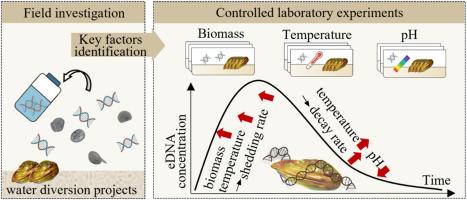量化关键因素对金贻贝eDNA脱落率和衰变率的影响
IF 8.4
2区 环境科学与生态学
Q1 ENVIRONMENTAL SCIENCES
引用次数: 0
摘要
环境DNA (Environmental DNA, eDNA)定量是一种新兴的检测水生环境中贻贝入侵的技术。了解不同环境条件下eDNA脱落和衰变的机制对于获得目标物种可靠的时空分布至关重要。金贻贝(Limnoperna fortunei)是淡水生态系统中具有代表性的入侵物种,其入侵和生物污染在世界范围内造成了重大的经济和生态破坏。本研究通过大引水工程的野外调查和室内实验,揭示了生物量、水温、pH等关键生态环境因子对金贻贝eDNA脱落和腐烂的影响。结果表明,生物量和水温与eDNA脱落率呈显著正相关。此外,高水温和低pH条件也会加速贻贝eDNA的衰变。本研究结果表明,在水样采集和定量分析过程中应考虑这些控制因素的影响,为利用eDNA技术进行入侵检测提供可靠的依据。本文章由计算机程序翻译,如有差异,请以英文原文为准。

Quantifying the effect of key factors on the shedding and decay rates of eDNA from the golden mussel
Environmental DNA (eDNA) quantification is an emerging technique for detecting invasive mussel in aquatic environments. Understanding mechanism of eDNA shedding and decaying under different environmental conditions are critical for obtaining reliable spatial and temporal distribution of the target species. As a representative invasive species in freshwater ecosystems, the golden mussel (Limnoperna fortunei) has caused significant economic and ecological damage worldwide through its invasion and biofouling. In this study, the effects of key eco-environmental factors including biomass, water temperature, and pH that influence eDNA shedding and decay of golden mussel were revealed through field investigations of grand water diversion project and laboratory experiments. The results revealed significant positive correlations between both biomass and water temperature with eDNA shedding rates. Additionally, high water temperatures and low pH conditions were found to accelerate the decay of mussel eDNA. The findings of this study indicate that the effects of these controlling factors should be considered during the collection and quantitative analysis processes of water samples to provide reliable base for invasion detection using eDNA technology.
求助全文
通过发布文献求助,成功后即可免费获取论文全文。
去求助
来源期刊

Journal of Environmental Management
环境科学-环境科学
CiteScore
13.70
自引率
5.70%
发文量
2477
审稿时长
84 days
期刊介绍:
The Journal of Environmental Management is a journal for the publication of peer reviewed, original research for all aspects of management and the managed use of the environment, both natural and man-made.Critical review articles are also welcome; submission of these is strongly encouraged.
 求助内容:
求助内容: 应助结果提醒方式:
应助结果提醒方式:


